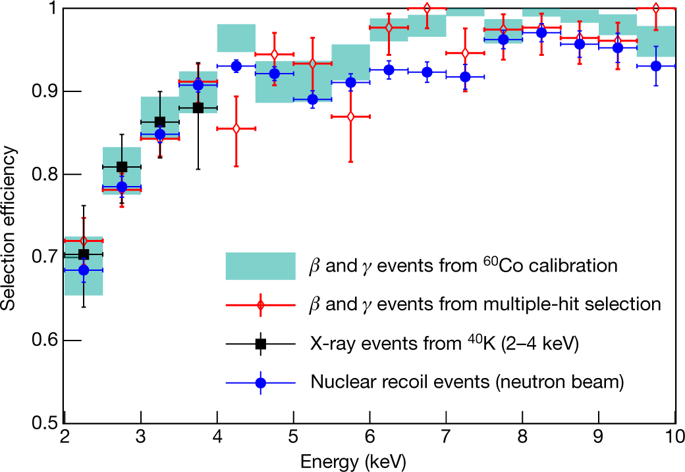Our official English website, www.x-mol.net, welcomes your feedback! (Note: you will need to create a separate account there.)
An experiment to search for dark-matter interactions using sodium iodide detectors
Nature ( IF 64.8 ) Pub Date : 2018-12-01 , DOI: 10.1038/s41586-018-0739-1
Nature ( IF 64.8 ) Pub Date : 2018-12-01 , DOI: 10.1038/s41586-018-0739-1

|
Observations of galaxies and primordial radiation suggest that the Universe is made mostly of non-luminous dark matter1,2. Several new types of fundamental particle have been proposed as candidates for dark matter3, such as weakly interacting massive particles (WIMPs)4,5. These particles would be expected to interact with nuclei in suitable detector materials on Earth, for example, causing them to recoil. However, no definitive signal from such dark-matter interactions has been detected despite concerted efforts by many collaborations6. One exception is the much-debated claim by the DAMA collaboration of a statistically significant (more than nine standard deviations) annual modulation in the rate of nuclear interaction events. Annual modulation is expected because of the variation in Earth’s velocity relative to the Galaxy’s dark-matter halo that arises from Earth’s orbital motion around the Sun. DAMA observed a modulation in the rate of interaction events in their detector7–9 with a period and phase consistent with that expected for WIMPs10–12. Several groups have been working to develop experiments with the aim of reproducing DAMA’s results using the same target medium (sodium iodide)13–17. To determine whether there is evidence for an excess of events above the expected background in sodium iodide and to look for evidence of an annual modulation, the COSINE-100 experiment uses sodium iodide as the target medium to carry out a model-independent test of DAMA’s claim. Here we report results from the initial operation of the COSINE-100 experiment related to the first task18,19. We observe no excess of signal-like events above the expected background in the first 59.5 days of data from COSINE-100. Assuming the so-called standard dark-matter halo model, this result rules out spin-independent WIMP–nucleon interactions as the cause of the annual modulation observed by the DAMA collaboration20–23. The exclusion limit on the WIMP–sodium interaction cross-section is 1.14 × 10−40 cm2 for 10-GeV c−2 WIMPs at a 90% confidence level. The COSINE-100 experiment will continue to collect data for two more years, enabling a model-independent test of the annual modulation observed by the DAMA collaboration. Early results from the COSINE-100 experiment—designed to test a much-debated claim of the detection of a dark-matter signal—show no indications of dark matter, providing evidence against the previous claim.
中文翻译:

使用碘化钠探测器寻找暗物质相互作用的实验
对星系和原始辐射的观察表明,宇宙主要由不发光的暗物质组成 1,2。已经提出了几种新型基本粒子作为暗物质的候选者 3,例如弱相互作用大质量粒子 (WIMP)4,5。例如,预计这些粒子会与地球上合适的探测器材料中的原子核相互作用,导致它们反冲。然而,尽管许多合作做出了共同努力,但尚未检测到来自这种暗物质相互作用的明确信号。一个例外是 DAMA 合作对核相互作用事件发生率具有统计显着性(超过九个标准差)的年度调制的声明,这一说法备受争议。由于地球围绕太阳的轨道运动产生的银河系暗物质晕,地球的速度会发生变化,因此预计会发生年度调制。DAMA 观察到其探测器 7-9 中相互作用事件速率的调制,其周期和相位与 WIMP10-12 的预期一致。几个小组一直致力于开发实验,目的是使用相同的目标培养基(碘化钠)13-17 重现 DAMA 的结果。为了确定是否有证据表明碘化钠中的预期背景以上的事件过多,并寻找年度调节的证据,COSINE-100 实验使用碘化钠作为目标介质,对 DAMA 进行了独立于模型的测试宣称。在这里,我们报告了与第一个任务相关的 COSINE-100 实验的初始操作结果18,19。在 COSINE-100 的前 59.5 天数据中,我们没有观察到超过预期背景的类似信号事件。假设所谓的标准暗物质晕模型,该结果排除了自旋独立的 WIMP-核子相互作用是 DAMA 合作观察到的年度调制的原因20-23。对于 10-GeV c-2 WIMP,WIMP-钠相互作用截面的排除限制为 1.14 × 10-40 cm2,置信度为 90%。COSINE-100 实验将继续收集两年以上的数据,从而能够对 DAMA 合作观察到的年度调制进行独立于模型的测试。
更新日期:2018-12-01
中文翻译:

使用碘化钠探测器寻找暗物质相互作用的实验
对星系和原始辐射的观察表明,宇宙主要由不发光的暗物质组成 1,2。已经提出了几种新型基本粒子作为暗物质的候选者 3,例如弱相互作用大质量粒子 (WIMP)4,5。例如,预计这些粒子会与地球上合适的探测器材料中的原子核相互作用,导致它们反冲。然而,尽管许多合作做出了共同努力,但尚未检测到来自这种暗物质相互作用的明确信号。一个例外是 DAMA 合作对核相互作用事件发生率具有统计显着性(超过九个标准差)的年度调制的声明,这一说法备受争议。由于地球围绕太阳的轨道运动产生的银河系暗物质晕,地球的速度会发生变化,因此预计会发生年度调制。DAMA 观察到其探测器 7-9 中相互作用事件速率的调制,其周期和相位与 WIMP10-12 的预期一致。几个小组一直致力于开发实验,目的是使用相同的目标培养基(碘化钠)13-17 重现 DAMA 的结果。为了确定是否有证据表明碘化钠中的预期背景以上的事件过多,并寻找年度调节的证据,COSINE-100 实验使用碘化钠作为目标介质,对 DAMA 进行了独立于模型的测试宣称。在这里,我们报告了与第一个任务相关的 COSINE-100 实验的初始操作结果18,19。在 COSINE-100 的前 59.5 天数据中,我们没有观察到超过预期背景的类似信号事件。假设所谓的标准暗物质晕模型,该结果排除了自旋独立的 WIMP-核子相互作用是 DAMA 合作观察到的年度调制的原因20-23。对于 10-GeV c-2 WIMP,WIMP-钠相互作用截面的排除限制为 1.14 × 10-40 cm2,置信度为 90%。COSINE-100 实验将继续收集两年以上的数据,从而能够对 DAMA 合作观察到的年度调制进行独立于模型的测试。



























 京公网安备 11010802027423号
京公网安备 11010802027423号